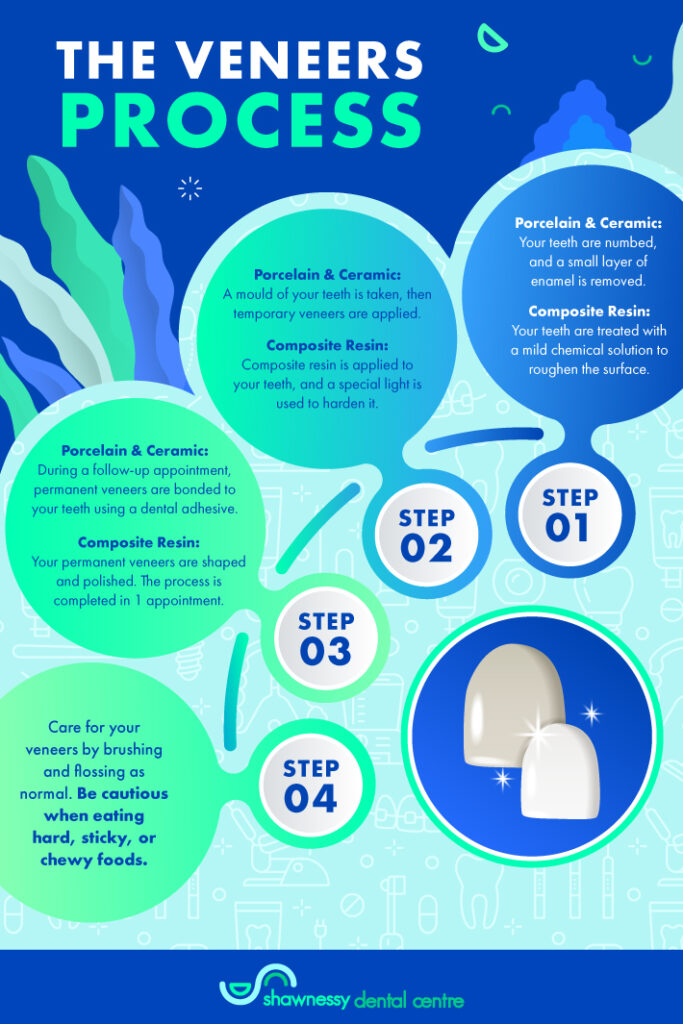Veneers are a popular choice for those looking to enhance their smile. These thin shells, typically made of porcelain, ceramic, or composite resin, are custom-designed to cover the front surface of your teeth.
Depending on the type of veneer you opt for, your dentist will prepare your teeth accordingly. Some alterations may be necessary to adhere the veneer properly. This could involve removing a small layer of enamel or using a gentle solution to roughen the tooth’s surface.
Before your veneer procedure, your dentist will provide you with the information and instructions you need to prepare. Don’t hesitate to ask any questions during your initial consultation. Your dentist is there to guide you through the process and help prepare you for the treatment.
Types of Veneers
When it comes to veneers, there are a few different types to choose from: porcelain, ceramic, and composite resin. Each type has its own unique qualities and benefits.
Porcelain
Porcelain veneers are known for their natural appearance and resistance to staining. With porcelain veneers, you can achieve a brighter smile that lasts. These veneers are designed to mimic the translucency of your teeth, giving you a natural-looking result.
Ceramic
Ceramic veneers, such as IPS Empress, are highly durable and offer excellent colour matching. These veneers are crafted with precision and can seamlessly blend with your natural teeth. If you’re looking for a veneer option that is both durable and aesthetically pleasing, ceramic veneers might be the right choice for you.
Composite Resin
If you prefer a less invasive option, composite resin veneers could be worth considering. Unlike other types of veneers, composite resin veneers require less enamel removal. They are a durable option that can enhance the appearance of your teeth.

How Veneers Are Applied
Your teeth will be prepped differently depending on the type of veneer you’re getting. For composite and porcelain veneers, you’ll typically have 2 sessions. The first will be for preparation, while the second will be for placing the veneers. Composite resin veneers are usually placed in just 1 session.
Steps for Placing Ceramic & Porcelain Veneers
Before applying ceramic or porcelain veneers, your dentist may numb your tooth with a local anesthetic. Then, they will gently remove a thin layer of enamel from your tooth. This is a necessary step to make room for the veneers.
After prepping your tooth, your dentist will take a mould of it. This mould will be used to create your custom veneers. During this time, your dentist may provide you with temporary veneers to protect your teeth while your permanent veneers are being crafted. Temporary veneers are used to help maintain your smile’s appearance and keep your teeth safe.
Once your permanent veneers are ready, your dentist will carefully bond them to your teeth using a special dental adhesive. They will make any necessary adjustments to ensure a comfortable fit and a natural appearance.
Steps for Placing Composite Resin Veneers
Before applying your composite resin veneers, your dentist will carefully match the composite resin to your natural tooth colour. This step helps your dentist choose a colour that blends in seamlessly with the rest of your teeth, giving you a natural-looking smile.
When it’s time to apply the veneers, your dentist will start by treating your tooth with a mild chemical solution. This solution roughens the surface of your tooth, making it easier for the composite resin to adhere firmly.
Next, your dentist will apply the composite resin to your teeth using a small brush. They will do this layer by layer, using a special light to harden each layer before applying the next one.
Once the final layer of composite resin has been applied and hardened, your dentist will shape and polish the veneer. During this process, they’ll blend the veneers seamlessly with your other teeth.
Aftercare for Veneers
Veneers are permanent, so taking care of them as if they’re your natural teeth is essential. Your dentist may provide you with advice on how to care for your veneers, but some general guidelines to follow include:
- Brush and floss regularly. Use a soft-bristle toothbrush and non-abrasive toothpaste to avoid scratching the surface of your veneers.
- Don’t bite or chew on hard objects. Although veneers are durable, they can still be susceptible to damage from excessive force.
- Wear a mouthguard during physical activities. This protective gear can help safeguard your veneers from potential damage.
- Visit your dentist regularly. Maintaining regular dental checkups is crucial for monitoring the health of your veneers and ensuring their longevity.

Get a Natural Look with Veneers
Veneers could be the solution for transforming your teeth and improving your smile. At Shawnessy Dental Centre, our team uses VITA Easyshade to precisely colour-match your veneers to your natural tooth shade. This technology allows us to create veneers that seamlessly blend in with your existing teeth.
If you’re considering veneers, book an appointment with our friendly and experienced team. We’ll be happy to discuss your options for veneers and help you determine whether they’re an option for you. Reach out to us today to get started.


